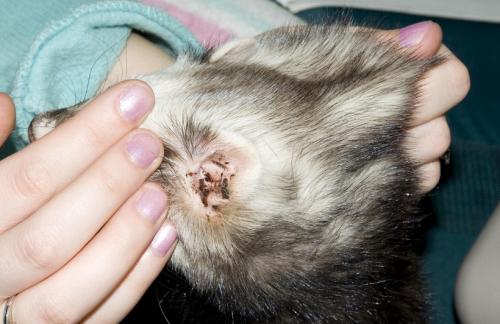Ear mites are parasitic insects that are mainly live outside the auditory canal of the animal. Most common the appearance of such ticks, otodectosis (otodectes cynotis), can live on dogs, cats and ferrets. The tick will feed on skin and blood. host, and leave behind a characteristic brown discharge. These ticks can be extremely contagious, as they are so small that can easily go unnoticed for long periods time.

If you do not rid the animal of ear mites, then this will lead to great discomfort with your pet. They will contribute infection, and also cause constant itching and scabies heads. This, in turn, can damage delicate tissues, ear structure, various inflammations and hair loss. AT while ear mites themselves are easily treatable, however, secondary diseases they cause can be quite painful for your pet.
How does ear tick infection occur?
Contents
The most likely source of infection for your ear mites A pet is another animal. Common litter or joint games can increase the likelihood of an animal becoming infected if it Do not clean regularly. Young animals are especially susceptible infection, especially those who live in close contact with by parents. All breeds of dogs, cats and ferrets can become infected.
Fortunately, ear mites cannot live long without a host and transmitted to humans. After you remove the ticks at all your pets, you don’t have to worry about using various chemicals in your home to permanently eradicate them.
What do ear mites look like?
Ear mites are smaller than fleas and lice, but they are not microscopic: if you gently wipe your pet’s ear canal with a cotton swab, then you can see tiny moving white dots – these spots are ticks. By looking at these points with microscope, you will see that they have long, protruding paws and round bodies.
What are the symptoms of ear mite infection?
The most obvious sign that your pet ear mites appeared, is a strong discomfort that will expressed in his behavior. Other signs of infection may be:
- constant scratching of the ears, neck and head (scabies)
- Shaking his head
- Strong smell
- Acne or suppuration in the ear
- Excessive amount of brown waxy discharge in ear canal
Dogs may suffer from tick allergies, which can cause severe discomfort and stress. If your dog is too much worried about your ears and you do not see any obvious signs injuries, the cause of this may be ear mites.
Please note that some animals, especially cats, may show no symptoms of ear mite infection, or show them very weakly. For this reason, any suspicious Cases must be submitted to the veterinarian. Your vet confirm infection by washing the ear and checking ticks under using a microscope, or using an otoscope to check inner ear. He or she can also do a full check. the body of the pet to confirm that there are no secondary infections.
If your pet does not allow the veterinarian to perform physical examination, then he may need a sedative to go through diagnostics.
How to treat ear mites?
Treatment is usually done at home, and you may need to the use of ear drops or other topical agents. If your the dog is very sensitive or you expect serious problems with self-use of funds, do not forget to talk about it to the vet.
Pets that have had severe scabies of ears may anti-inflammatory painkillers should be prescribed, or, Elizabethan collar may be needed to prevent further damage to the ear tissue. Make sure you wash and washed all bedding and toys that could to be infected. If you have other pets, then you protective measures will need to be taken in order to cure or prevent their infection. Do not forget that you cannot Get rid of ear mites by simply washing your pet’s ears.
What can be the complications caused by ear mites?
Skin infections are the most common consequence of prolonged ear mite infections. One of the most serious complications could be be an hematoma of the ear:
- When your pet scratches its ears or shakes its head, one or multiple blood vessels inside the ear (or auricle) may burst.
- Blood can fill the subcutaneous space in the ear and slowly accumulate.
- The ear can swell and swell a lot, and if the animal isn’t provide emergency assistance, this can lead to irreversible mutilation of the ear.
This injury can be extremely painful and can require prolonged treatment. Ear hematoma almost always is a secondary disease caused by an advanced disease or another injury.
How to prevent re-infection?
Prevent re-infection by ear mites in most animals are pretty simple. There are several tools that, when monthly use will protect against ear ticks and cats, and dogs, however, they are only available on prescription. The good news is that these remedies are also very effective against fleas and even some types of helminths. However, it is important to remember that many funds are not suitable for puppies and kittens, so they will need special preparations for the treatment of ear mites.
Periodic ear cleaning can also be of great benefit. animal, but you should talk about it with the veterinarian, which means or tools will suit your pet.






